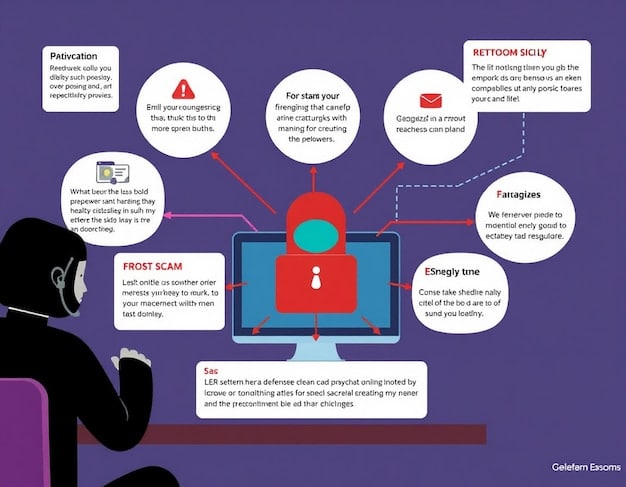Remote Work and Cybersecurity: Secure Data at Home in 2025

Remote work in 2025 necessitates robust cybersecurity measures to protect sensitive data from home, including advanced threat detection, employee training, secure network configurations, and compliance with evolving data privacy regulations.
The rise of remote work has transformed how businesses operate, offering flexibility and convenience. However, this shift also introduces significant cybersecurity challenges. In 2025, protecting sensitive data from home will be critical, requiring a proactive and comprehensive approach to Remote Work and Cybersecurity: Protecting Sensitive Data from Home in 2025.
Understanding the Evolving Threat Landscape
As remote work becomes more prevalent, the threat landscape is constantly evolving. Cybercriminals are increasingly targeting remote workers, exploiting vulnerabilities in home networks and personal devices.
Understanding these threats is crucial for developing effective cybersecurity strategies.
Common Cybersecurity Threats in Remote Work
Remote workers face a variety of cybersecurity threats that extend beyond those encountered in a traditional office environment. These can range from simple phishing attempts to sophisticated ransomware attacks.
- Phishing Attacks: Cybercriminals use fraudulent emails or messages to trick employees into revealing sensitive information.
- Malware Infections: Malicious software can be inadvertently downloaded onto devices, compromising data and network security.
- Ransomware: This type of malware encrypts a victim’s files, demanding a ransom for their release.
- Unsecured Networks: Public Wi-Fi networks and poorly configured home networks can be easily exploited by attackers.

Addressing these threats requires a multi-faceted approach, including employee training, robust security software, and secure network configurations. Staying informed about the latest cybersecurity risks is essential to protecting sensitive data in the remote work environment.
Implementing Robust Security Policies
Effective security policies are fundamental to protecting sensitive data in a remote work environment. These policies should address a wide range of issues, from acceptable use of devices to data handling procedures.
A well-defined policy can help mitigate risks and ensure that employees understand their responsibilities in maintaining cybersecurity.
Key Components of a Remote Work Security Policy
A comprehensive remote work security policy should include detailed guidelines on various aspects of cybersecurity. It should provide clear instructions and expectations for employees when working from home.
- Acceptable Use Policy: Defines how company devices and networks should be used, including restrictions on personal use.
- Data Handling Procedures: Outlines how sensitive data should be stored, transmitted, and accessed to prevent unauthorized disclosure.
- Password Management: Requires employees to use strong, unique passwords and provides guidelines on secure password storage.
- Incident Response Plan: Specifies the steps to be taken in the event of a security breach or data compromise.
Regularly reviewing and updating security policies is essential to address emerging threats. By providing clear and consistent guidelines, companies can empower employees to make informed decisions and protect sensitive data.
Securing Home Networks and Devices
One of the biggest challenges in remote work cybersecurity is ensuring the security of home networks and personal devices. These environments are often less secure than traditional office networks, making them attractive targets for cybercriminals.
Securing these endpoints is crucial to maintaining overall data protection.
Best Practices for Home Network Security
Securing a home network involves implementing several key measures to protect against unauthorized access and malware infections. These practices ensure that the network is robust and resilient against cyber threats.
- Use a Strong Password: Change the default password on your Wi-Fi router to a strong, unique password.
- Enable Encryption: Use WPA3 encryption to secure your Wi-Fi network and protect data in transit.
- Update Firmware: Regularly update the firmware on your router to patch security vulnerabilities.
- Guest Network: Create a separate guest network for visitors to keep your main network secure.
By implementing these practices, remote workers can significantly enhance the security of their home networks and reduce the risk of cyberattacks. Consistent monitoring and maintenance are essential to a secure environment.
Employee Training and Awareness Programs
Employees are often the first line of defense against cyberattacks. Therefore, comprehensive training and awareness programs are essential for promoting a security-conscious culture within the organization.
Educating employees about cybersecurity best practices can significantly reduce the risk of successful attacks.
Essential Elements of Cybersecurity Training
Effective cybersecurity training should cover a range of topics, including identifying phishing emails, recognizing malware threats, and understanding data handling procedures. Training should be engaging, relevant, and regularly updated to address emerging threats.
- Phishing Simulations: Conduct regular phishing simulations to test employees’ ability to identify and report fraudulent emails.
- Safe Browsing Practices: Teach employees how to identify and avoid malicious websites.
- Data Protection: Educate employees on the importance of protecting sensitive data and following data handling procedures.
- Incident Reporting: Provide clear instructions on how to report security incidents and potential breaches.
Continuous training and awareness programs help employees stay informed about the latest threats and reinforce the importance of cybersecurity. By empowering employees with the knowledge and skills to recognize and respond to cyberattacks, organizations can create a more secure remote work environment.
Leveraging Advanced Cybersecurity Technologies
In 2025, advanced cybersecurity technologies will play a critical role in protecting sensitive data in remote work environments. These technologies can provide real-time threat detection, automated response capabilities, and enhanced data protection.
Adopting these technologies can significantly improve an organization’s cybersecurity posture.

Key Cybersecurity Technologies for Remote Work
Several advanced technologies are particularly well-suited for securing remote work environments. These technologies can help organizations monitor and control access to sensitive data and detect and respond to cyber threats in real-time.
- Endpoint Protection Platforms (EPP): EPP solutions provide comprehensive security for laptops, desktops, and mobile devices, protecting against malware, ransomware, and other threats.
- Secure Access Service Edge (SASE): SASE combines network security functions with wide area network (WAN) capabilities to provide secure, reliable access to cloud-based resources.
- Data Loss Prevention (DLP): DLP systems monitor data in transit and at rest to prevent sensitive information from leaving the organization’s control.
- AI-Powered Threat Detection: Artificial intelligence and machine learning algorithms can analyze network traffic and user behavior to identify and respond to anomalies that may indicate a cyberattack.
By leveraging these advanced technologies, organizations can enhance their cybersecurity defenses and better protect sensitive data in remote work environments. Regular evaluations and updates are essential to keep pace with the evolving threat landscape.
Compliance and Data Privacy Regulations
Organizations must comply with various data privacy regulations to protect sensitive information. These regulations often have specific requirements for data handling, storage, and access, which are particularly relevant in remote work environments.
Ensuring compliance is essential for maintaining trust with customers and avoiding legal penalties.
Key Data Privacy Regulations
Several data privacy regulations have a significant impact on how organizations handle sensitive data in remote work environments. Understanding and complying with these regulations is critical for maintaining data protection and avoiding costly penalties.
- General Data Protection Regulation (GDPR): The GDPR governs the processing of personal data of individuals within the European Union (EU).
- California Consumer Privacy Act (CCPA): The CCPA gives California residents greater control over their personal information.
- Health Insurance Portability and Accountability Act (HIPAA): HIPAA protects the privacy and security of protected health information (PHI).
- Payment Card Industry Data Security Standard (PCI DSS): PCI DSS provides a set of security standards for organizations that handle credit card information.
Compliance with these regulations requires organizations to implement specific security measures and data handling procedures. Regular audits and assessments are essential for ensuring ongoing compliance and identifying potential gaps in data protection.
In conclusion, as remote work becomes more entrenched in the business landscape, the need for robust cybersecurity measures will only intensify. By understanding the evolving threat landscape, implementing proactive security policies, and leveraging advanced technologies, organizations can protect sensitive data and ensure the continued success of their remote work initiatives.
| Key Point | Brief Description |
|---|---|
| 🛡️ Robust Security Policies | Implement comprehensive guidelines for device use, data handling, and password management. |
| 🏠 Secure Home Networks | Use strong passwords, enable encryption, and regularly update firmware on routers. |
| 🧑💻 Employee Training | Educate employees about phishing, malware, safe browsing, and data protection. |
| 🔒 Advanced Technologies | Leverage EPP, SASE, DLP, and AI-powered threat detection for enhanced security. |
FAQ
What are the key cybersecurity threats facing remote workers?
▼
Remote workers face threats like phishing attacks, malware infections, ransomware, and unsecured networks, which can compromise sensitive data.
▼
Best practices include using strong passwords, enabling WPA3 encryption, updating router firmware regularly, and creating a guest network.
▼
Employee training educates workers about recognizing and avoiding cyber threats, promoting a security-conscious culture within the organization.
▼
Technologies like Endpoint Protection Platforms (EPP), Secure Access Service Edge (SASE), and Data Loss Prevention (DLP) can enhance security.
What data privacy regulations should organizations comply with?
▼
Organizations should comply with GDPR, CCPA, HIPAA, and PCI DSS to protect sensitive data and maintain customer trust.
Conclusion
In conclusion, protecting sensitive data in a remote work environment requires a holistic and proactive approach. By implementing robust security policies, securing home networks, training employees, leveraging advanced technologies, and complying with data privacy regulations, organizations can mitigate cybersecurity risks and ensure the continued success of remote work initiatives in 2025 and beyond.





